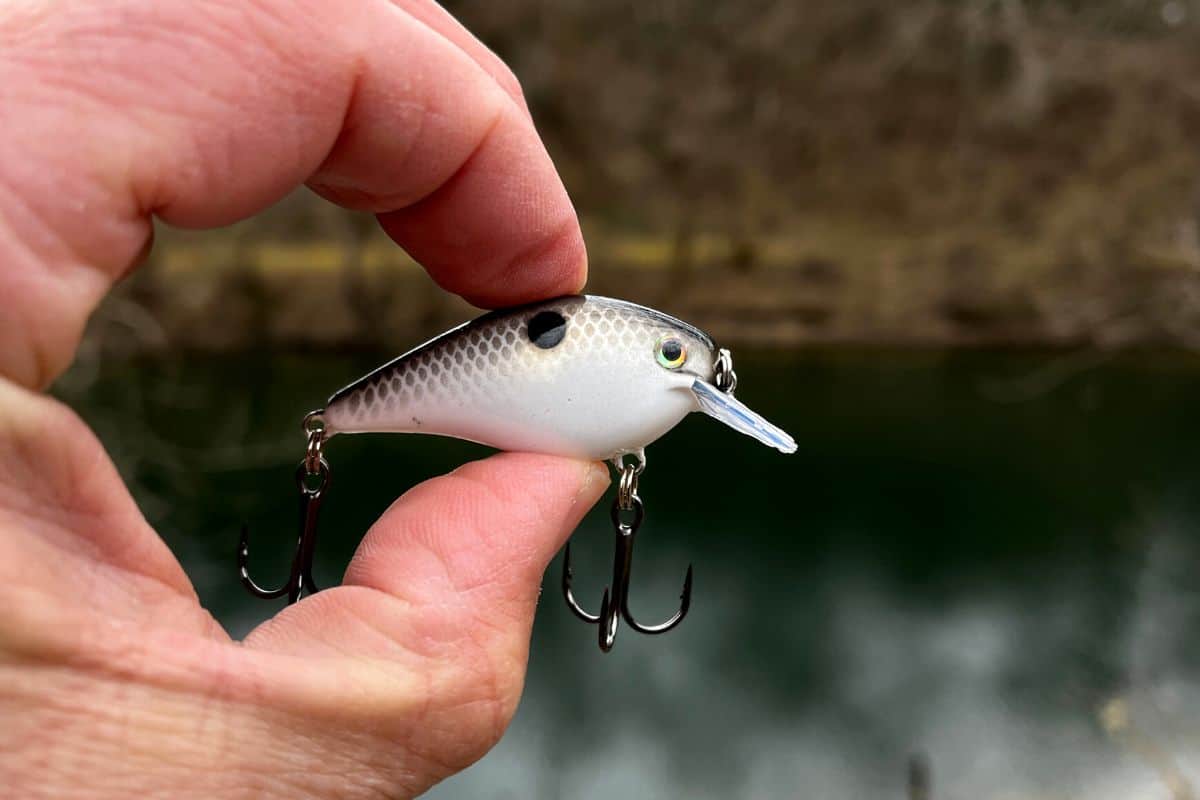Micro crankbaits are often overlooked by bass anglers, but these tiny offerings should be included in every tackle box.
Small crankbaits excel at locating fish. Tiny cranks also work the top of the water column over submerged cover efficiently and can activate entire schools of fish when used correctly.
An article by Rick Clunn in Bassmaster Magazine in the May ‘22 issue highlighted his thoughts on small crankbaits and how they are now his go-to lure for locating fish.
“I knew that little baits will show you numbers of fish when the bigger baits may not. The bigger baits work well when the bass are more aggressive, but if you don’t hit that short time frame, you don’t realize what actually lives there.” – Rick Clunn, Bassmaster Magazine
To summarize, Rick was talking about how bass fishing has changed over his career. In today’s Elite series he explains how he needs to fish bigger baits for fewer bites to be successful. But in practice, rarely does the bigger bait let you know what is really in an area. Unless, as he mentions in the above quote, you happen to hit the spot when the bass are most aggressive. Which we all know is a rare occurrence.
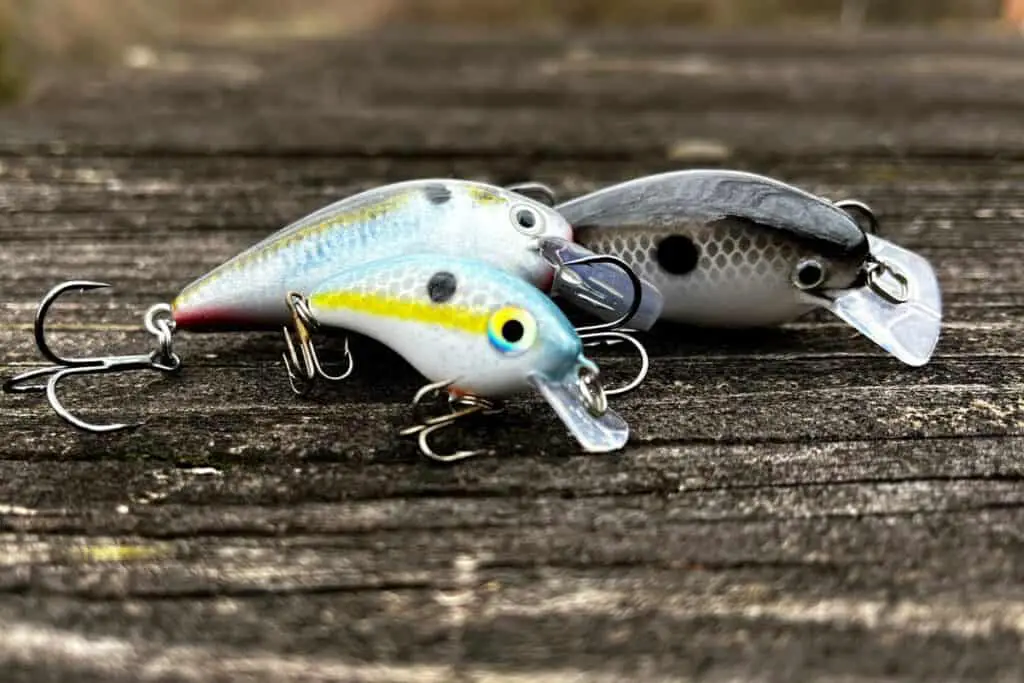
What is Considered a Small Crankbait?
Rick talks about the old Bagley Honey B. This tiny squarebill is 1 ½ inches long and weighs a ¼ oz. Most small lures, like the Honey B are floaters.
I love to use the Strike King KVD 1.0, the Series 1, 1XS and the Bitsy Pond Minnow.
Other anglers have had great success with the Rapala Ott’s Garage Tiny 4 and the Chubbs Lures Shallow Squarebill.
The below Table will give you an idea of the length and weight of these various tiny crankbaits.
| Lure Model | Length in Inches | Weight in Ounces |
| Bagley Honey B | 1 1/2″ | 1/4 oz |
| Strike King Bitsy Pond Minnow | 1 1/4″ | 1/8 oz |
| Strike King KVD 1.0 | 2″ | 1/4 oz |
| Strike King Series 1 | 2″ | 3/8 oz |
| Rapala Ott’s Garage Tiny 4 | 2 1/4″ | 5/16 oz |
| Chubbs Lures Shallow Squarebill | 2″ | 1/4 oz |
You may have noticed that all of these lures are indeed squarebill crankbaits. This lip design keeps the lure up in the water column and is excellent at deflecting off cover and ripping through shallow grass.
A squarebill crankbait also can be burned at incredible speeds and still run true. Burning squarebills is one of the most effective tactics to get inactive bass to bite. It is impossible to burn these lures too fast for the bass to catch them. An erratic stop-and-start retrieve is the most effective presentation for my squarebill fishing.
(Here is an article on squarebills of all sizes.)
The sudden change in speed often forces bass to react, just like when the lure deflects off something and alters its direction

The Mental Approach to Using Small Crankbaits
There is something mentally challenging about tying on a micro squarebill. These baits often get “labeled” as panfish lures or something that kids use. That couldn’t be further from reality.
If you never found yourself trying one of these lures, it takes a bite or two before the confidence level ramps up. And when you catch that first quality bass on a small squarebill it will be something you always have at the ready.
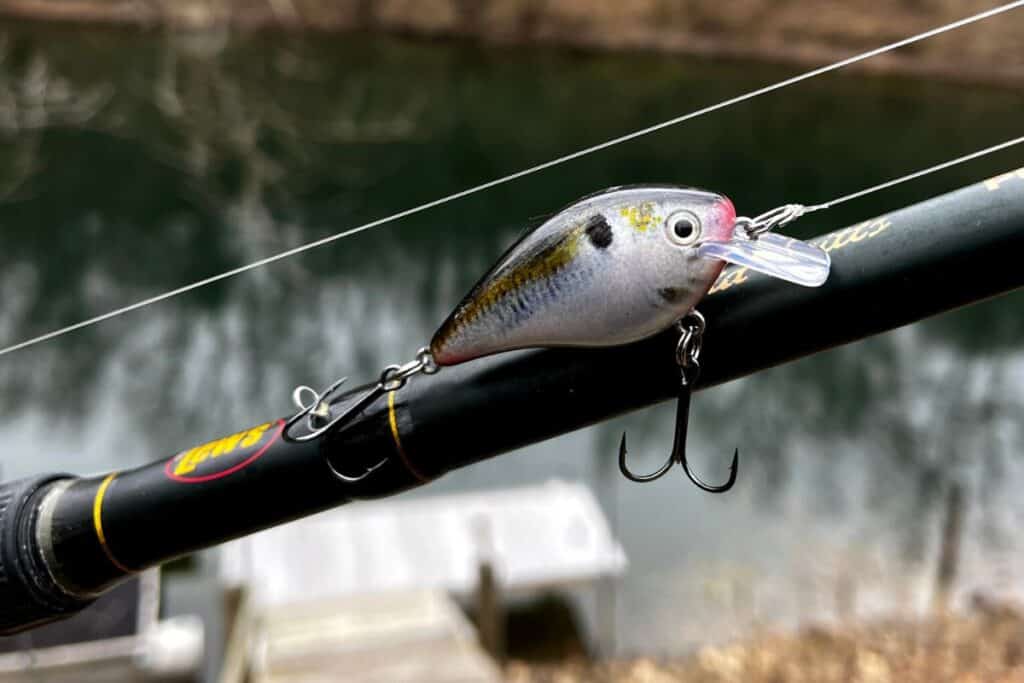
The Equipment for Throwing Small Crankbaits
Because of their size, many anglers assume that spinning gear is what needs to be used for these tiny lures. Spinning gear will work great, but tiny cranks can be thrown successfully on baitcasting equipment.
I prefer to use a baitcast reel for two important reasons. First, my accuracy is much better with a baitcast reel both for location and the ability to thumb the spool to stop the lure from flying too far.
Second, most often I am burning small squarebills and the gear ratios of baitcast reels offer me more options than spinning gear.
I use a 7 ft David Fritts Perfect Crankbait Rod that is a medium power rating and a moderate action. The whip of this rod throws small crankbaits with ease and the parabolic action keeps me from ripping the lure out of the mouth of the bass when they hit.
I pair this lure with a straight fluorocarbon line anywhere from 10-pound to 15-pound test. I get more distance on my cast with the smaller diameter 10-pound test line, but the added toughness of the heavier line is something I prefer when fishing around rocks and other debris.
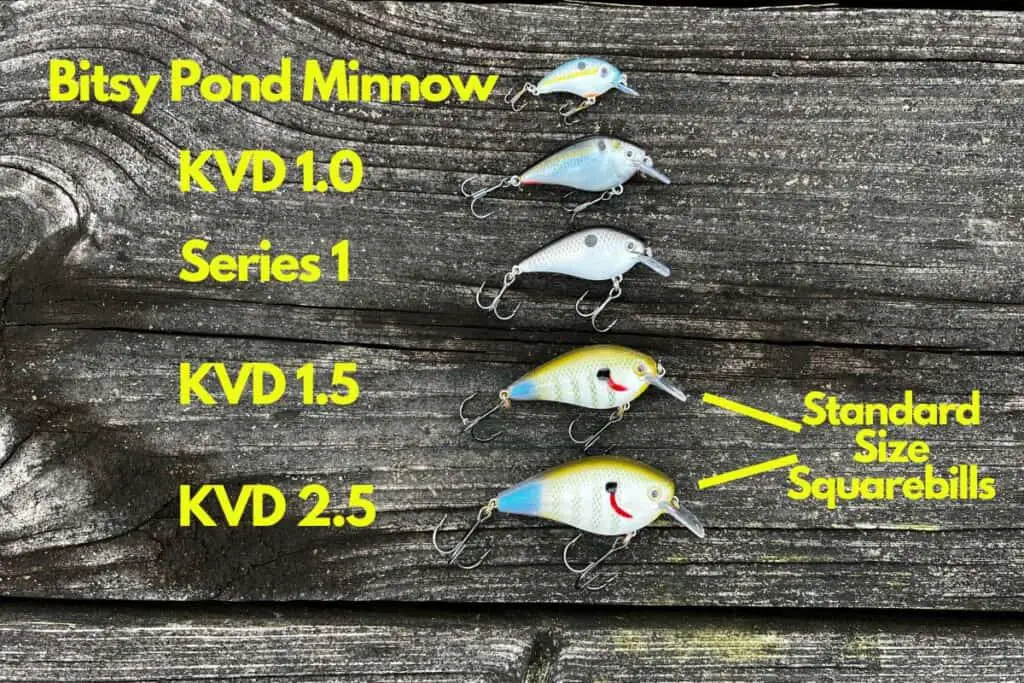
Where and How to Use Small Crankbaits
When I opt for a small crankbait, there are usually a couple of reasons. First, the bite is probably tougher than I was hoping for. Top pros call these finesse crankbaits for a reason. Bass will hit them when they let larger offerings pass by.
Second, I will use them when I am covering a lot of water and want to locate fish. This is exactly what Rick Clunn finds so appealing about tiny cranks. He can go through an area in practice and figure out what is really in there. Then on tournament day, he can always use larger lures to try and coax bigger fish into hitting.
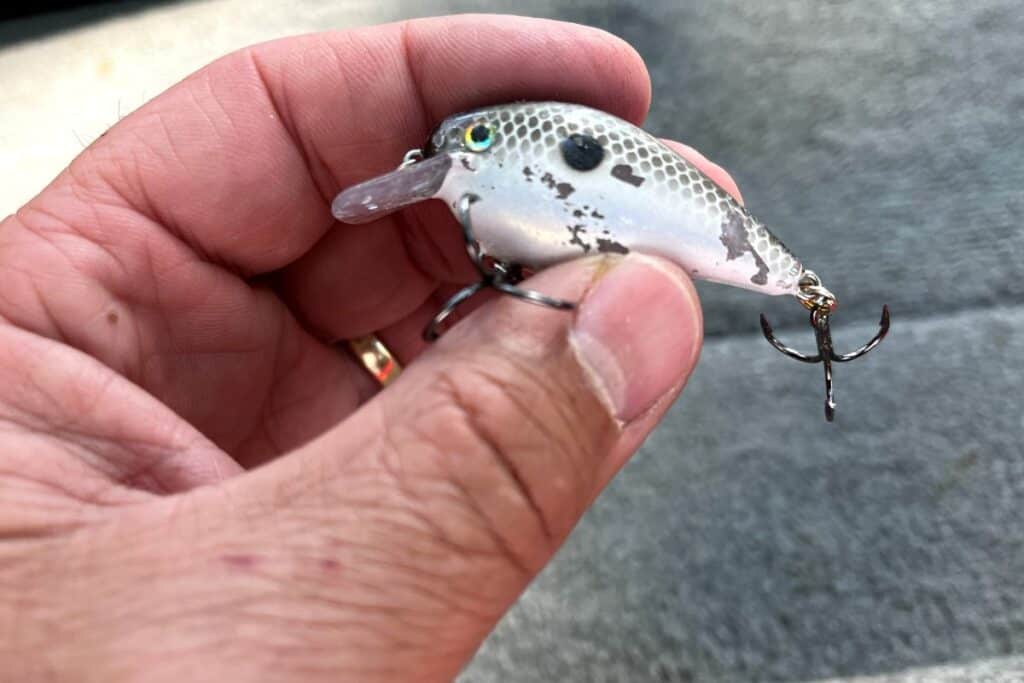
Using Small Crankbaits For Finesse Presentations
There are times when it seems impossible to get a bite. Most bass anglers will then switch to a finesse presentation and slow down – a lot.
This works, but there is one major drawback to this approach. What if the bass are not there?
Standard finesse presentations like a drop shot, Ned rig, and shaky head worm are not known for covering massive amounts of water looking for fish. If you are an angler that has forward-facing sonar and knows there are fish in front of you, that is a blessing. Many folks do not have that luxury and forward-facing sonar still struggles when trying to scan through thick vegetation.
A small crankbait will present an easy meal to bass, trigger bass of all sizes to bite, and yet cover the water necessary to find where the fish are holding.
There is one undeniable fact I have learned from hundreds of hours filming underwater – bass are rarely alone.
If there is something about an area one bass finds appealing, odds are others will too. This could be due to optimum oxygen levels, an abundance of bait, water temperature, current, or a host of other factors.
If we use that finesse-sized crankbait to get a bass to reveal itself, no matter the size, we can be confident there are probably more in the area. It is at this point we can switch to a different finesse presentation and slow down to work a location thoroughly.
How to Cover Water With Small Crankbaits
As mentioned earlier, most of the time I will burn these tiny squarebills with a start-stop retrieve.
My goal is to force a bass to react. Most of the time our favorite game fish is not in the mood to bite. A true reaction bite can best be described in this manner:
Imagine someone comes up to you and starts flicking their fingers right in your face. It won’t take long and you instinctively react to it. Maybe you swat their hands away or yell at them to stop. Either way, the result is the same, you reacted. A bass can only react to irritating stimuli in two ways – attack it or swim off.
It is this exact reason why suspending jerkbaits are the most powerful reaction lure out there. They will catch bass that are in a negative mood and force the feeding instinct to activate.
I prefer to parallel a shoreline when burning tiny crankbaits so I can keep the lure in the zone the longest. When casting perpendicular to the shoreline the lake or river bed most often drops off. If you are fishing from the shore it will do the opposite and get shallower.
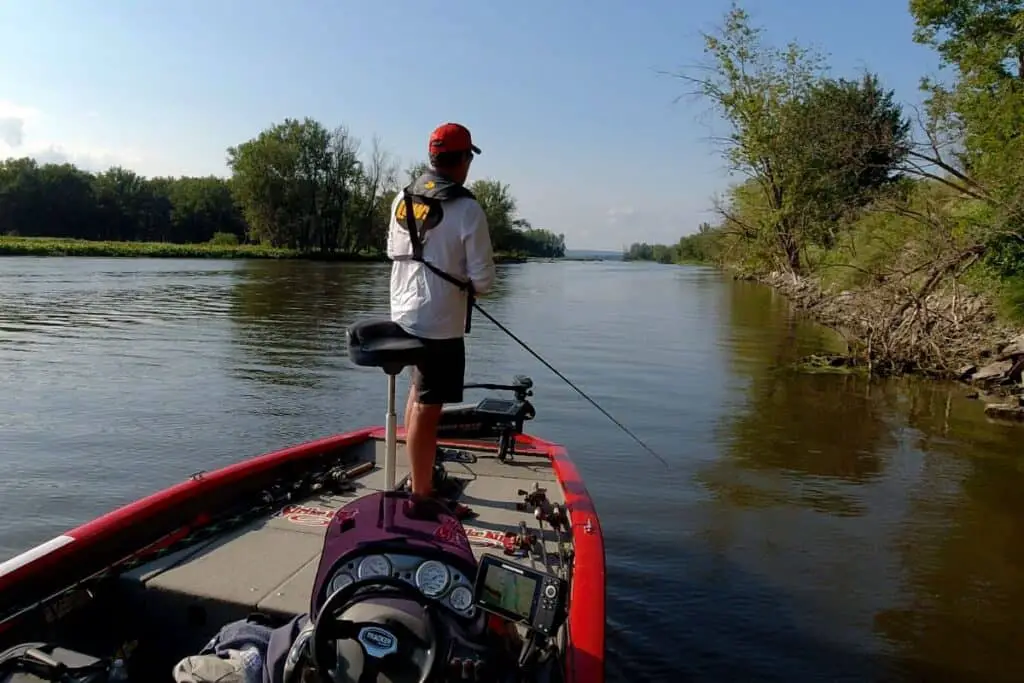
Paralleling allows me to target a specific depth and then adjust it easily.
When burning the lure, crank it as fast as you can. This can be exhausting, but it works and works well. Reel hard for a few cranks, then pause, then start up again. Keep adjusting the length and frequency of the pause to see if there is something the bass like best.
If you snag vegetation, let it hang there a second and then rip the rod to bust the bait free. Many times this is when a bass will annihilate the lure. If you are fishing rocks and burning the lure and get stuck, let the bait float back up on a pause, or work to the other side of the rock and the crankbait will usually pop right off.
When I run across specific targets, like laydowns, then I will slow the retrieve down for a few casts and let the squarebill bounce and deflect its way into and around the limbs. Be sure to cast at the wood from multiple angles. If the bass are in a repressed mood, it may take repeated casts to a single target to force the fish to react.
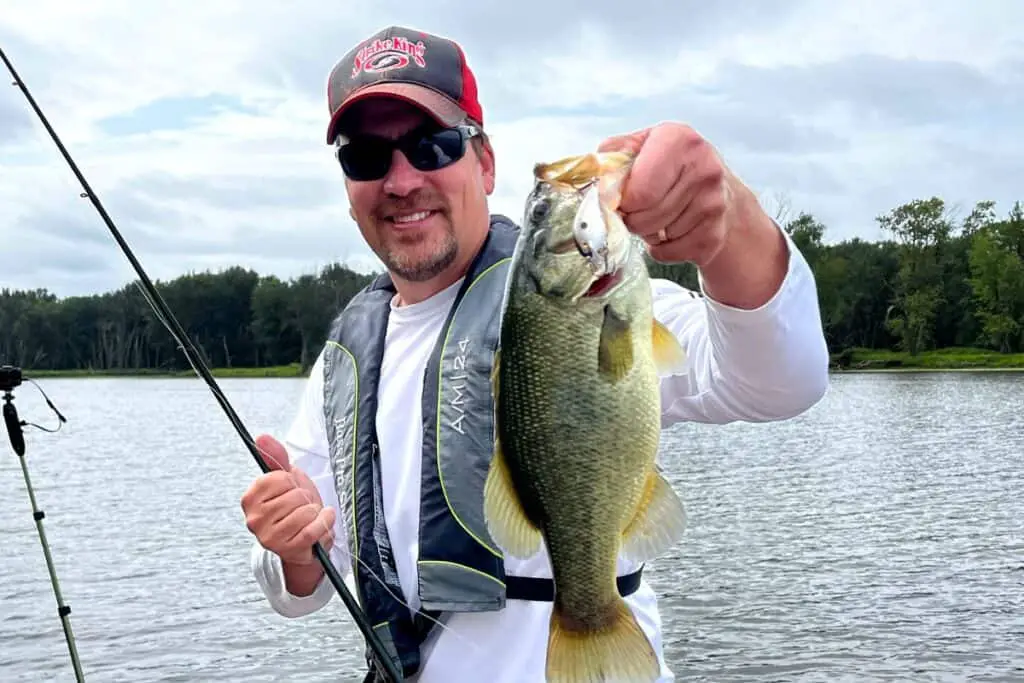
My Favorite Season for Small Crankbaits
While tiny cranks will work all year, especially in the winter along rip-rap, my favorite time to use them is in the fall.
Bass will really focus on baitfish in the months leading up to winter. This feeding frenzy is more pronounced in northern climates, but it is present about everywhere temperatures take a significant dip.
When this strong baitfish focus takes place the bass can and will be anywhere. It is not uncommon to find them in the middle of a lake or in places you have never caught a bass before. Be on the lookout for the prey and small crankbaits will dominate in these situations.
The wind is a major factor in positioning microorganisms like zooplankton. The baitfish will follow this movement and then predators won’t be far behind. Observing shorebirds like herons and egrets will also clue anglers into the presence of bait.
Burning small crankbaits in the fall can result in some of the best fishing you have all year.
Good luck and be sure to encourage someone today. You never know how you may change their life forever.
Isaiah 6:8

